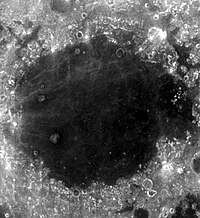Mare Crisium
 Mare Crisium | |
| Diameter | 555 km (345 mi)[1] |
|---|---|
| Eponym | Sea of Crises |
Mare Crisium (the "Sea of Crises") is a lunar mare located in the Moon's Crisium basin, just northeast of Mare Tranquillitatis. The basin is of the Pre-Imbrian period, 4.55 to 3.85 billion years ago.
Characteristics
Mare Crisium is 555 km (345 mi) in diameter,[1] and 176,000 km2 in area. It has a very flat floor, with a ring of wrinkled ridges toward its outer boundaries. Ghost craters (craters that have largely been buried under deposits of other material), are located to the south.[2]
The mare has many notable features in and around it. The cape-like feature protruding into the southeast of the mare is Promontorium Agarum. On the western rim of the mare is the palimpsest Yerkes. The crater Picard is located just to the east of Yerkes, and northwest of Picard is the crater Peirce. Mare Anguis can be seen northeast of Mare Crisium.[3]
Names
Like most of the other maria on the Moon, Mare Crisium was named by Giovanni Riccioli, whose 1651 nomenclature system has become standardized.[4]
By the 17th century, Mare Crisium had acquired the name 'Caspian Sea', being labelled as such by Thomas Harriot, Pierre Gassendi and Michael Van Langren. Ewen A. Whitaker speculates that it received this name because it occupies roughly the same position on the Moon's face as does the Caspian Sea on Earth, with respect to maps of Europe, North Africa and the Middle East.[5] The English astronomer William Gilbert's map of c.1600 calls it 'Brittania' after Britain.[6]
Observation and exploration
Mare Crisium is just visible from Earth with the naked eye as a small dark spot on the edge of the Moon's face.
It is the site of the crash-landing of Soviet Luna 15 probe in 1969. A soil sample from Mare Crisium was successfully brought to Earth on 22 August 1976 by the Soviet lunar mission Luna 24.
In popular culture
- In Robert A. Heinlein's novel The Moon is a Harsh Mistress, Mare Crisium is the site of a lunar colony named Luna City.
- "The Sentinel", the short story from which Arthur C. Clarke developed the film 2001: A Space Odyssey with Stanley Kubrick, takes place on the Mare Crisium.
- The Brazilian death metal band Krisiun supposedly based their name on the crater.[citation needed]
References
- ^ a b "Moon Mare/Maria". Gazetteer of Planetary Nomenclature. USGS Astrogeology. Retrieved 2010-08-20.
- ^ Autostar Suite Astronomer Edition. CD-ROM. Meade, April 2006.
- ^ "Mare Crisium". lunar.arc.nasa.gov. Retrieved October 18, 2007.
- ^ Ewen A. Whitaker, Mapping and Naming the Moon (Cambridge University Press, 1999), p.61.
- ^ Ewen A. Whitaker, Mapping and Naming the Moon (Cambridge University Press, 1999), p.7.
- ^ Ewen A. Whitaker, Mapping and Naming the Moon (Cambridge University Press, 1999), p.7.
External links
